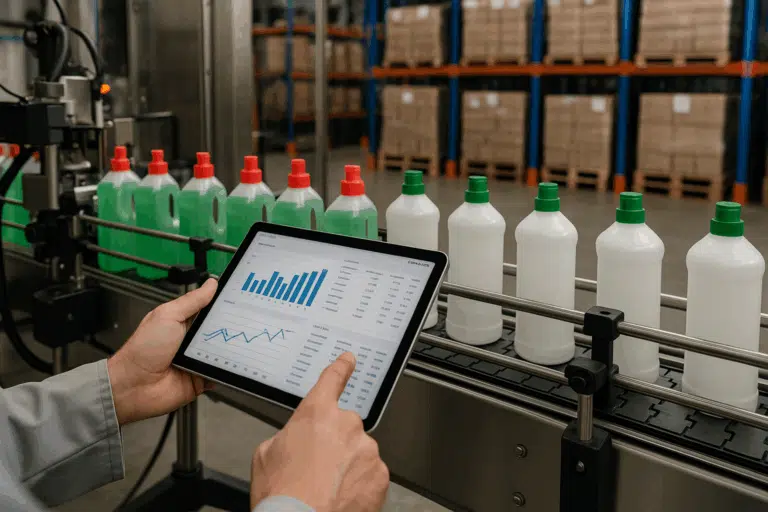Today’s world demands faster tasks, which is why an RFID inventory system is essential for businesses. It uses radio frequency identification to accurately track products. This helps businesses save time and money by reducing errors that can occur with manual tracking.
This article will explore how RFID works and its benefits. We will also look at how businesses can use it to improve inventory management.
Table of Contents
ToggleUnderstanding RFID Technology
RFID technology, or Radio Frequency Identification, is a complex process used in many areas, especially in inventory management systems. It helps businesses work more efficiently by accurately tracking their assets and inventory.
What is RFID?
RFID is a system that uses tags and readers to communicate through radio waves. Each tag has a microchip with data and an antenna. This lets it send information to RFID readers. This setup makes it easier to collect data, making inventory records more accurate.
How RFID Works in Inventory Management
RFID makes it possible to track items in real-time in inventory management systems. It uses radio waves to read data from tags on products. This method cuts down on mistakes and keeps stock levels correct. It also helps keep inventory control more efficient and saves time on manual checks.
| Feature | Benefit |
|---|---|
| Real-Time Tracking | Ensures accurate stock levels at all times |
| Automated Data Collection | Reduces manual errors and saves time |
| Increased Efficiency | Streamlines inventory processes |
| Enhanced Visibility | Improves decision-making based on live data |
Benefits of Implementing an RFID System for Inventory
Using an RFID system in inventory management offers many advantages. It helps improve inventory accuracy, leading to better operational efficiency and cost savings. Companies that use RFID can make their processes more profitable, staying competitive.
Increased Accuracy in Inventory Tracking
RFID technology greatly reduces errors in inventory management. It provides real-time data, helping organizations track their warehouse more accurately. This results in seamless inventory accounting!
With accurate tracking, businesses can ensure they have the right products at the right time. This results in happier customers and increased sales.
Enhanced Productivity and Operational Efficiency
RFID systems can significantly increase productivity in warehouses and distribution centers. Employees spend less time on manual counts and data entry, allowing them to focus on more important tasks.
With RFID, order processing becomes faster and delivery times are shorter, improving performance across all departments.
Cost Reduction through Improved Inventory Management
Adopting RFID can lead to significant cost savings, especially in inventory turnover and supply chain operations. Better stock level oversight helps companies make better purchasing decisions. This reduces holding costs.
By improving inventory management, businesses can save money. They can then invest in areas that help them grow even more.
RFID System for Inventory: Key Features to Look For
When looking at RFID systems for inventory management, focus on key features. These features boost efficiency and performance. They include real-time updates and integration with current software.
Real-Time Data Collection and Reporting
Real-time data collection is a top RFID feature. It helps businesses know their inventory levels right away. This reduces the chance of running out of stock or having too much.
Getting updates in real-time helps make quick decisions. It lets companies adjust their stock management fast. With up-to-date inventory info, operations can run smoother and respond quickly to demand changes.
Integration with Existing Systems and Software
Another key feature is easy integration with current systems. This means less change to what you already do. Companies like SAP and Oracle have solutions that work well with RFID.
Choosing RFID systems that fit with these platforms helps businesses. It keeps workflows running smoothly without disrupting them.
Challenges in Adopting RFID Systems
Starting to use RFID technology can be tricky. Companies face big hurdles like the cost, training needs, and managing change. Knowing these issues is key for businesses wanting to use RFID well in managing their inventory.
Initial Costs and Investment Considerations
One big challenge is the initial cost. It includes buying hardware, software, and setting it up, plus ongoing upkeep. Even though it seems expensive at first, looking at the long-term gains is important. Many businesses see big savings, better accuracy, and more efficiency with RFID.
Training and Change Management for Staff
Getting RFID systems to work well depends on good training and change management. Companies need to make sure their team knows how to use the new tech. Training staff well helps them work better and lessens resistance to change. Managing the change smoothly helps everyone adjust to the new tech.
| Challenge | Considerations |
|---|---|
| Initial Costs | Evaluate short-term vs. long-term financial impacts. |
| Training Staff | Implement comprehensive training programs. |
| Change Management | Develop strategies to ease the transition process. |
Conclusion
Implementing an RFID system for inventory can change how businesses manage their stock. It brings many benefits, like better tracking and cost savings. This makes RFID systems a key tool for success in today’s market.
RFID technology is more than just an option for inventory management. It’s a must-have for companies looking to improve. It helps businesses cut down on waste and meet customer needs fast.
It’s time for businesses to look at their inventory management. An RFID system can make a big difference. Investing in this technology is a smart move for companies wanting to grow in a digital world.
FAQ
What is RFID technology?
RFID (Radio Frequency Identification) technology helps track items by using radio waves. It connects tags on objects to readers. This makes managing inventory more efficient.
How does an RFID system improve inventory management?
RFID systems give real-time updates on stock levels. They cut down on mistakes and automate tracking. This speeds up work and boosts accuracy, saving money and improving control.
What are the key benefits of implementing an RFID system for inventory?
RFID systems make tracking inventory more accurate. They also make operations smoother and cut costs. This is due to better inventory turnover and supply chain management.
Are there any challenges associated with adopting an RFID system?
Yes, there are challenges. High costs for setup and training are needed. But, with good planning, these can be managed.
What features should I look for in an RFID system?
Look for real-time data and easy integration with current systems. It should also support your inventory needs well.
Can RFID systems be integrated with existing inventory management software?
Yes, many RFID systems work with software like SAP and Oracle. This makes operations smooth without changing everything.
How does RFID contribute to cost reduction in inventory management?
RFID improves accuracy and reduces stock errors. This leads to better supply chain management. It means fewer stockouts and overstocks, saving money.
What kind of training is needed for staff implementing an RFID system?
Staff need to learn how to use RFID readers and software. They also need to understand the data. Good training ensures the system works well.





























